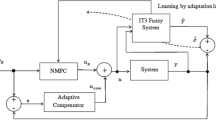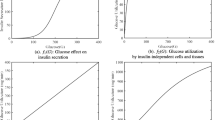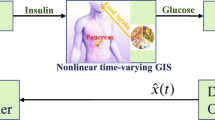Abstract
This paper presents a support fuzzy adaptive system for a hybrid proportional derivative controller that will refine its parameters during postprandial periods to enhance performance. Even though glucose controllers have improved over the last decade, tuning them and keeping them tuned are still major challenges. Changes in a patient’s lifestyle, stress, exercise, or other activities may modify their blood glucose system, making it necessary to retune or change the insulin dosing algorithm. This paper presents a strategy to adjust the parameters of a proportional derivative controller using the so-called safety auxiliary feedback element loop for type 1 diabetic patients. The main parameters, such as the insulin on board limit and proportional gain are tuned using postprandial performance indexes and the information given by the controller itself. The adaptive and robust performance of the control algorithm was assessed “in silico” on a cohort of virtual patients under challenging realistic scenarios considering mixed meals, circadian variations, time-varying uncertainties, sensor errors, and other disturbances. The results showed that an adaptive strategy can significantly improve the performance of postprandial glucose control, individualizing the tuning by directly taking into account the intra-patient variability of type 1 patients.

A fuzzy inference engine was implemented within a clinically tested artificial pancreas control system. The aim of the fuzzy system was to adapt controller parameters to improve postprandial blood glucose control while ensuring safety. Results show a significant improvement over time of the postprandial glucose response due to the adaptation, thus demonstrating the usefulness of the fuzzy adaptive system.













Similar content being viewed by others
References
Control TD, Trial C (1993) The effect of intensive treatment of diabetes on the development and progression of long-term complications in insulin-dependent diabetes mellitus. N Engl J Med 329:977–986. https://doi.org/10.1056/NEJM199309303291401
Steil GM, Rebrin K, Darwin C, Hariri F, Saad MF (2006) Feasibility of automating insulin delivery for the treatment of type 1 diabetes. Diabetes 55:3344–3350. https://doi.org/10.2337/db06-0419
Weinzimer SA, Steil GM, Swan KL, Dziura J, Kurtz N, Tamborlane WV (2008) Fully automated closed-loop insulin delivery versus semiautomated hybrid control in pediatric patients with type 1 diabetes using an artificial pancreas. Diabetes Care 31:934–939. https://doi.org/10.2337/dc07-1967
Ellingsen C, Dassau E, Zisser H, Grosman B, Percival MW, Jovanovič L, Doyle FJ 3rd (2009) Safety constraints in an artificial pancreatic beta cell: an implementation of model predictive control with insulin on board. J Diabetes Sci Technol 3:536–544
Hovorka R (2011) Closed-loop insulin delivery: from bench to clinical practice. Nat Rev Endocrinol 7:385–395. https://doi.org/10.1038/nrendo.2011.32
Lee H, Bequette BW (2009) A closed-loop artificial pancreas based on model predictive control: human-friendly identification and automatic meal disturbance rejection. Biomed Signal Process Control 4:347–354. https://doi.org/10.1016/j.bspc.2009.03.002
Lunze K, Singh T, Walter M, Brendel MD, Leonhardt S (2013) Blood glucose control algorithms for type 1 diabetic patients: a methodological review. Biomed Signal Process Control 8:107–119. https://doi.org/10.1016/j.bspc.2012.09.003
Magni L, Raimondo DM, Bossi L, Man CD, De Nicolao G, Kovatchev B, Cobelli C (2007) Model predictive control of type 1 diabetes: an in silico trial. J Diabetes Sci Technol 1:804–812
Magni L, Raimondo DM, Dalla Man C, De Nicolao G, Kovatchev B, Cobelli C (2009) Model predictive control of glucose concentration in type I diabetic patients: an in silico trial. Biomed Signal Process Control 4:338–346. https://doi.org/10.1016/j.bspc.2009.04.003
Percival MW, Wang Y, Grosman B, Dassau E, Zisser H, Jovanovič L, Doyle FJ (2011) Development of a multi-parametric model predictive control algorithm for insulin delivery in type 1 diabetes mellitus using clinical parameters. J Process Control 21:391–404. https://doi.org/10.1016/j.jprocont.2010.10.003
Parker RS, Doyle FJ, Ward JH, Peppas NA (2000) Robust H∞ glucose control in diabetes using a physiological model. AICHE J 46:2537–2546. https://doi.org/10.1002/aic.690461220
Ruiz-Velázquez E, Femat R, Campos-Delgado DU (2004) Blood glucose control for type I diabetes mellitus: a robust tracking H∞ problem. Control Eng Pract 12:1179–1195. https://doi.org/10.1016/j.conengprac.2003.12.004
Gallardo Hernández AG, Fridman L, Levant A, Shtessel Y, Leder R, Revilla Monsalve C, Islas Andrade S (2013) High-order sliding-mode control for blood glucose: practical relative degree approach. Control Eng Pract 21:747–758. https://doi.org/10.1016/j.conengprac.2012.11.015
Vargas L, Mauricio F (2013) Design and implementation of a closed-loop blood glucose control system in patients with type 1 diabetes. Universitat de Girona, Girona
León-Vargas F, Garelli F, De Battista H, Vehí J (2013) Postprandial blood glucose control using a hybrid adaptive PD controller with insulin-on-board limitation. Biomed. Signal Process. Control. 8:724–732. https://doi.org/10.1016/j.bspc.2013.06.008
Revert A, Garelli F, Pico J, De Battista H, Rossetti P, Vehi J, Bondia J (2013) Safety auxiliary feedback element for the artificial pancreas in type 1 diabetes. Biomed Eng IEEE Trans 60:2113–2122
Marchetti G, Barolo M, Jovanovic L, Zisser H, Seborg DE (2006) An improved PID switching control strategy for type 1 diabetes. Conf Proc IEEE Eng Med Biol Soc 1:5041–5044. https://doi.org/10.1109/IEMBS.2006.259541
Palerm CC (2011) Physiologic insulin delivery with insulin feedback: a control systems perspective. Comput Methods Prog Biomed 102:130–137. https://doi.org/10.1016/j.cmpb.2010.06.007
Ruiz JL, Sherr JL, Cengiz E, Carria L, Roy A, Voskanyan G, Tamborlane WV, Weinzimer SA (2012) Effect of insulin feedback on closed-loop glucose control: a crossover study. J. Diabetes Sci. Technol. 6:1123–1130. https://doi.org/10.1177/193229681200600517
Weinzimmer SA, Dziura J, Steil GM, Kurtz N, Swan KL, Tamborlane WV (2008) Fully automated closed-loop insulin delivery versus semiautomated hybrid control in pediatric patients with type 1 diabetes using an artificial pancreas. Diabetes Care 31:934–939. https://doi.org/10.2337/dc07-1967.S.A.W
Lee C-S, Wang M-H (2011) A fuzzy expert system for diabetes decision support application. IEEE Trans Syst Man Cybern Part B 41:139–153. https://doi.org/10.1109/TSMCB.2010.2048899
Goharimanesh M, Lashkaripour A, Shariatnia S, Akbari AA (2014) Diabetic control using genetic fuzzy-PI controller. Int J Fuzzy Syst 16:133–139
Mollaei N, Moghaddam RK (2014) A new controlling approach of type 1 diabetics based on interval type-2 fuzzy controller. Journal of Fuzzy Set Valued Analysis 2014:1–14
Doyle FJ, Huyett LM, Lee JB, Zisser HC, Dassau E (2014) Closed-loop artificial pancreas systems: engineering the algorithms. Diabetes Care 37:1191–1197. https://doi.org/10.2337/dc13-2108
Trevitt S, Simpson S, Wood A (2015) Artificial pancreas device systems for the closed-loop control of type 1 diabetes: what systems are in development? J Diabetes Sci Technol 1932296815617968. https://doi.org/10.1177/1932296815617968
Ly TT, Roy A, Grosman B, Shin J, Campbell A, Monirabbasi S, Liang B, von Eyben R, Shanmugham S, Clinton P, Buckingham BA (2015) Day and night closed-loop control using the integrated Medtronic hybrid closed-loop system in type 1 diabetes at diabetes camp. Diabetes Care 38:1205–1211. https://doi.org/10.2337/dc14-3073
Thabit H, Lubina-Solomon A, Stadler M, Leelarathna L, Walkinshaw E, Pernet A, Allen JM, Iqbal A, Choudhary P, Kumareswaran K, Nodale M, Nisbet C, Wilinska ME, Barnard KD, Dunger DB, Heller SR, Amiel SA, Evans ML, Hovorka R (2014) Home use of closed-loop insulin delivery for overnight glucose control in adults with type 1 diabetes: a 4-week, multicentre, randomised crossover study. Lancet Diabetes Endocrinol 2:701–709. https://doi.org/10.1016/S2213-8587(14)70114-7
Kropff J, Del Favero S, Place J, Toffanin C, Visentin R, Monaro M, Messori M, Di Palma F, Lanzola G, Farret A, Boscari F, Galasso S, Magni P, Avogaro A, Keith-Hynes P, Kovatchev BP, Bruttomesso D, Cobelli C, DeVries JH, Renard E, Magni L (2015) 2 month evening and night closed-loop glucose control in patients with type 1 diabetes under free-living conditions: a randomised crossover trial. Lancet Diabetes Endocrinol 3:939–947. https://doi.org/10.1016/S2213-8587(15)00335-6
Messori M, Kropff J, Del Favero S, Place J, Visentin R, Calore R, Toffanin C, Di Palma F, Lanzola G, Farret A, Boscari F, Galasso S, Avogaro A, Keith-Hynes P, Kovatchev BP, Bruttomesso D, Magni L, DeVries JH, Renard E, Cobelli C, for the AP@home consortium (2017) Individually adaptive artificial pancreas in subjects with type 1 diabetes: a one-month proof-of-concept trial in free-living conditions. Diabetes Technol Ther 19:dia.2016.0463. https://doi.org/10.1089/dia.2016.0463
Elleri D, Allen JM, Kumareswaran K, Leelarathna L, Nodale M, Caldwell K, Cheng P, Kollman C, Haidar A, Murphy HR, Wilinska ME, Acerini CL, Dunger DB, Hovorka R (2013) Closed-loop basal insulin delivery over 36 hours in adolescents with type 1 diabetes. Diabetes Care 36:838–844. https://doi.org/10.2337/dc12-0816
León-Vargas F, Garelli F, De Battista H, Vehí J (2015) Postprandial response improvement via safety layer in closed-loop blood glucose controllers. Biomed Signal Process Control 16:80–87. https://doi.org/10.1016/j.bspc.2014.10.003
Wilinska ME, Chassin LJ, Schaller HC, Schaupp L, Pieber TR, Hovorka R (2005) Insulin kinetics in type-1 diabetes: continuous and bolus delivery of rapid acting insulin. IEEE Trans Biomed Eng 52:3–12. https://doi.org/10.1109/TBME.2004.839639
Leon-Vargas F, Prados G, Bondia J, Vehi J (2011) A new virtual environment for testing and hardware implementation of closed-loop control algorithms in the artificial pancreas. Proc Annu Int Conf IEEE Eng Med Biol Soc EMBS:385–388. https://doi.org/10.1109/IEMBS.2011.6090124
Dalla Man C, Rizza RA, Cobelli C (2007) Meal simulation model of the glucose-insulin system. IEEE Trans Biomed Eng 54:1740–1749. https://doi.org/10.1109/TBME.2007.893506
Herrero P, Bondia J, Palerm CC, Vehí J, Georgiou P, Oliver N, Toumazou C (2012) A simple robust method for estimating the glucose rate of appearance from mixed meals. J Diabetes Sci Technol 6:153–162. https://doi.org/10.1177/193229681200600119
Funding
This work was supported by the Spanish Ministry of Science and Innovation under Grants DPI2013-46982-C2-2-R and DPI2016-78831-C2-2-R, by the Autonomous Government of Catalonia under Grant 2014 SGR 1052 and by the Formación de Professorado Universitario (FPU0244 2015) doctoral scholarship.
Author information
Authors and Affiliations
Corresponding author
Appendix
Appendix
1.1 Overview of the fuzzy system
The presented fuzzy system is a multiple-input multiple-output (MIMO) system. Particularly, the system considers five input and two output variables as shown in Fig. 14.
The fuzzy inference engine is based on the Mamdani method. When using the Mamdani method the inference is performed in four stages: (1) fuzzification of the crisp inputs, (2) rule evaluation, (3) aggregation of the outputs, and (4) defuzzification of the output fuzzy set.
Prior to the description of the fuzzy system engine, let us make some definitions that will be used throughout the text.
Definition 1
The universe of discourse X is a collection of objects {x} that can be discrete or continuous.
Definition 2
Let X be the universe of discourse with elements {x}. Then, a fuzzy membership function is defined as
where A is a fuzzy set, and if μA(x) = 1 means that x is in A, μA(x) = 0 means x is not in A and 0 < μA(x) < 1 means that x belongs to A up to a certain degree.
Definition 3
The degree of membership is the value that takes μA(x) ∈ [0, 1] given an object {x} of the universe of discourse X.
Definition 4
The linguistic variable constitutes the range of possible values that can take the universe of discourse of that variable.
Definition 5
A fuzzy rule is a conditional statement of the form.
IF (antecedents), THEN (consequences).
where the antecedents and consequences are relations between linguistic variables and their fuzzy sets. The antecedents are referred to the input linguistic variables, and for the consequences the output linguistic variables.
1.2 Fuzzification
The fuzzification process starts by taking the input crisp linguistic variables and determining the degree of membership for their respective membership functions. Specifically, we consider five input linguistic variables: (1) meanGmin, (2) meanExcursion, (3) mean#switch04, (4) mean#switch48, and (5) meanToff. We designed three membership functions for each input variable. The membership functions are labeled by the linguistic terms Small, Normal, and High. The universes of discourse for all input variables are continuous and their elements belong to \( {\mathbb{R}}_0^{+} \). Figures 15, 16, 17, 18, and 19 show the membership functions for the five input variables.
All of the designed membership functions are based on trapezoidal shapes with linear hedges defined as follows:
where the parameter set (a, b, c, d) define the domain of each sub-function of the piecewise trapezoidal membership function, e.g., the Normal membership function from Fig. 15 is defined by μNormal(x| 70,80,90,100).
We used trapezoidal shapes to lower the computational burden of more complex shapes, and also because they describe well enough the knowledge of the experts who participated in the system design.
The fuzzification process is performed by taking a specific crisp value of the input variables and evaluating the degree of membership. For example, for an input mean_Excursion = 70 mg/dl, the membership functions tell us that the particular excursion belongs 50% to Small, 50% to Normal and 0% to High. This process is performed for each input over all the membership functions. The output of the fuzzification process is the degree of membership of all the input variables to each of their fuzzy membership functions.
1.3 Rule evaluation
In this step, the rules stored at the rule database are used to apply the fuzzified inputs to the rule antecedents. The rule database of the system is composed by the following rules
-
1.
IF meanGmin is Small, THEN, IOBmax is Decrease.
-
2.
IF meanGmin is High AND meanExcursion is High, THEN, IOBmax is IncreaseLittle.
-
3.
IF meanGmin is High, THEN, kp is IncreaseLittle.
-
4.
IF meanTOFF is Small AND meanGmin is Small, THEN, IOBmax is DecreaseLittle.
-
5.
IF meanTOFF is High AND meanGmin is High, THEN, IOBmax is IncreaseLittle.
-
6.
IF meanSwitch04 is Small, THEN, kp is IncreaseLittle.
-
7.
IF meanSwitch04 is High, THEN, kp is DecreaseLittle.
-
8.
IF meanSwitch48 is High, THEN, kp is Decrease.
-
9.
IF meanSwitch48 is Small OR meanSwitch48 is Normal, THEN, kp is NoChange.
-
10.
IF meanGmin is Normal AND meanExcursion is Normal, THEN IOBmax is NoChange AND kp is NoChange.
-
11.
IF meanTOFF is High, THEN, IOBmax is Increase.
-
12.
IF meanTOFF is High AND meanGmin is Normal, THEN, IOBmax is IncreaseLittle and kp is NoChange.
-
13.
IF meanTOFF is Small AND mean#switch04 is High, THEN IOBmax is Increase.
-
14.
IF meanTOFF is High AND mean#switch04 is Small, THEN IOBmax is Decrease.
-
15.
IF meanExcursion is Normal OR meanExcursion is High, THEN, IOBmax is IncreaseLittle.
Both the antecedents and consequences can have multiple parts. These parts can use the fuzzy union (OR) and intersection (AND) operators. The union and intersection of two fuzzy sets A and B are defined as follows:
Using these operations, the system evaluates the antecedents of the rule to obtain the truth number. Then, this number is used to obtain the degree of membership of the output variables by applying the rule consequences.
For the output variables kp and IOBmax, we designed identical membership functions as shown in Figs. 20 and 21.
By maintaining a sufficient overlap between adjacent membership functions, we tried to ensure a smooth response of the fuzzy system. Here, we clipped the consequent membership functions based on the degree of membership of the antecedent.
1.4 Aggregation of the outputs
Once all the rules have been evaluated, the clipped consequent sets are all combined into a single fuzzy set. The union operator is used to that aim. This generates an overall fuzzy output set.
1.5 Defuzzification
The defuzzification is a process that allows us to obtain a single value out of the overall fuzzy output set. In this application, the single value is contained in the universe of discourse of the output linguistic variables, i.e., [− 0.15, 0.15]. The system uses the mCoA defined as follows:
where f(x) represents the overall fuzzy output set and x belongs to the output domain. Therefore, the system takes the centroid of gravity of the overall fuzzy output. The x that corresponds to the centroid of gravity is taken as the output of the fuzzy inference engine.
Rights and permissions
About this article
Cite this article
Beneyto, A., Vehi, J. Postprandial fuzzy adaptive strategy for a hybrid proportional derivative controller for the artificial pancreas. Med Biol Eng Comput 56, 1973–1986 (2018). https://doi.org/10.1007/s11517-018-1832-1
Received:
Accepted:
Published:
Issue Date:
DOI: https://doi.org/10.1007/s11517-018-1832-1
Keywords
Profiles
- Aleix Beneyto View author profile












